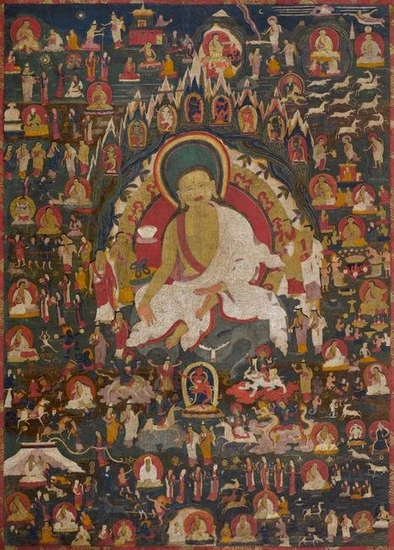A THANGKA OF MILAREPA TIBET, 15TH/16TH CENTURY
A THANGKA OF MILAREPA
TIBET, 15TH/16TH CENTURY
Distemper on cloth.
Himalayan Art Resources item no. 18340
37 1/4 x 26 in. (94.5 x 66 cm)
Footnotes:
西藏 十五/十六世紀 密勒日巴唐卡
Seated atop an antelope skin at the center of this vibrant thangka is Milarepa (1040–1123), possibly the most influential figure not only in the development of the Kagyu tradition, but in the history of Tibetan Buddhism. In contrast to his usual iconography, which depicts the singing saint cupping his ear with his hand, the artist has chosen a more relaxed pose for Milarepa outstretching his right palm in the gesture of wish-granting (varada mudra). Here, he does not appear to the viewer as an emaciated old man, but rather as a golden youth, whose trance-like expression and slightly opened mouth convey a deep level of concentration towards his music. Surrounding him is a retinue of dakinis and yabyum deities residing within a mountain range of sharp, flickering peaks, alluding to the central scene taking place at Mount Kailash.
This crowded arrangement of Buddhas, historical figures, and retinue deities like the Five Long Life Sisters, which insert Milarepa into nearly every episode, is likely based on the biographical tales composed by the historian Tsangnyon Heruka (1452-1507) in 1488. While each scene is labelled by a Tibetan inscription in gold, some are identifiable by visual cues alone. For example, the scene located directly to the viewer's left from the central image narrates an episode in which the Goddess Tseringma summons a horde of blue-skinned and skeletal demons to attack Milarepa. This episode is continued in another scene directly above, which concludes with the defeat of Tseringma and her subsequent conversion and spiritual journey into Buddhism.
In both its powerful modelling and deeply expressive eyes, this lot relates closely in quality to a number of Mahasiddha paintings dated to the 15th and 16th centuries with golden complexions, surrounded by a warm environment of red, green, and blue washes. See three such examples on HAR 18332, HAR 31223 & HAR 59884.
Provenance:
Galerie Koller Zurich, Auktion 79/3, 24/25 Mai 1991, tafel 6, nr. 175
Richard R. & Magdalena Ernst Collection
Sotheby's, New York, 22 March 2018, lot 932
Sale price
Estimate
Reserve
Time, Location
Auction House
A THANGKA OF MILAREPA
TIBET, 15TH/16TH CENTURY
Distemper on cloth.
Himalayan Art Resources item no. 18340
37 1/4 x 26 in. (94.5 x 66 cm)
Footnotes:
西藏 十五/十六世紀 密勒日巴唐卡
Seated atop an antelope skin at the center of this vibrant thangka is Milarepa (1040–1123), possibly the most influential figure not only in the development of the Kagyu tradition, but in the history of Tibetan Buddhism. In contrast to his usual iconography, which depicts the singing saint cupping his ear with his hand, the artist has chosen a more relaxed pose for Milarepa outstretching his right palm in the gesture of wish-granting (varada mudra). Here, he does not appear to the viewer as an emaciated old man, but rather as a golden youth, whose trance-like expression and slightly opened mouth convey a deep level of concentration towards his music. Surrounding him is a retinue of dakinis and yabyum deities residing within a mountain range of sharp, flickering peaks, alluding to the central scene taking place at Mount Kailash.
This crowded arrangement of Buddhas, historical figures, and retinue deities like the Five Long Life Sisters, which insert Milarepa into nearly every episode, is likely based on the biographical tales composed by the historian Tsangnyon Heruka (1452-1507) in 1488. While each scene is labelled by a Tibetan inscription in gold, some are identifiable by visual cues alone. For example, the scene located directly to the viewer's left from the central image narrates an episode in which the Goddess Tseringma summons a horde of blue-skinned and skeletal demons to attack Milarepa. This episode is continued in another scene directly above, which concludes with the defeat of Tseringma and her subsequent conversion and spiritual journey into Buddhism.
In both its powerful modelling and deeply expressive eyes, this lot relates closely in quality to a number of Mahasiddha paintings dated to the 15th and 16th centuries with golden complexions, surrounded by a warm environment of red, green, and blue washes. See three such examples on HAR 18332, HAR 31223 & HAR 59884.
Provenance:
Galerie Koller Zurich, Auktion 79/3, 24/25 Mai 1991, tafel 6, nr. 175
Richard R. & Magdalena Ernst Collection
Sotheby's, New York, 22 March 2018, lot 932



